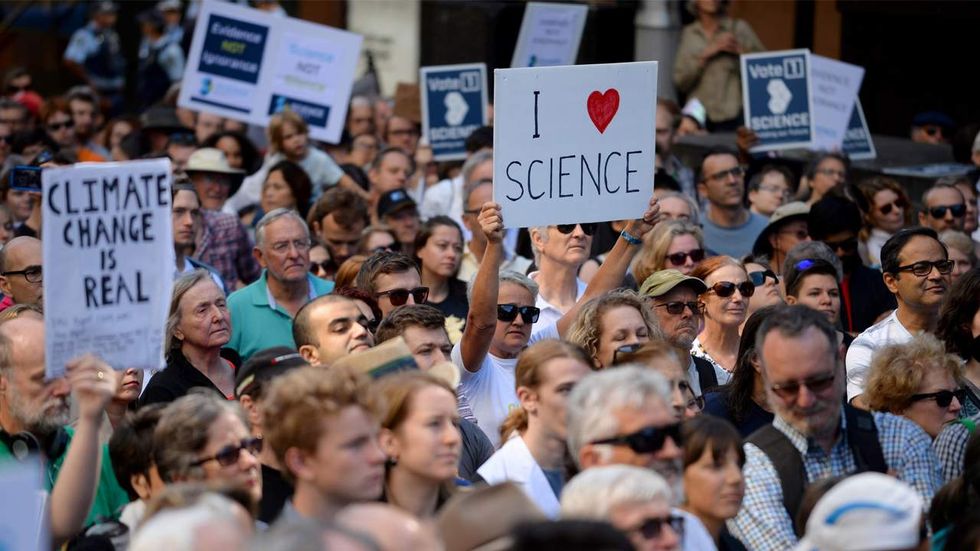
Scientists and others concerned about science gather across the country to protest policies enacted by the Trump administration and to "defend" science. (PETER PARKS/AFP/Getty Images)

Thousands of people are expected to rally across the United States on Saturday, Earth Day, to participate in the March for Science, a collection of events meant to oppose Trump administration policies some have alleged are harmful to science and to support science in general. The largest rally and march is expected to take place in Washington, DC, where protesters have already begun to gather.
According to the March for Science website, “the rally will be a call for politicians to implement science based policies, as well as a public celebration of science and the enormous public service it provides in our democracy, our economy, and our daily lives.”
Organizers have told scientists attending the rallies to wear their “work clothes,” which might include “lab coat, goggles, a stethoscope, field gear — scientists work in all settings and we shouldn’t limit the march to any specific kind.” Organizers are also encouraging people to dress as their “favorite scientist” and to carry signs showing their support for science.
“It might have been ignited by Trump, but it’s not about Trump,” said Lydia Villa-Komaroff, an honorary co-chair of the March for Science, according to CNN. “It’s about the importance of science in society and continuing the support for the science community in keeping our edge.”
Other supporters and organizers of the event have echoed similar sentiments: It’s not just about Trump, it’s about protecting science.
But protecting science from what, exactly?
The marches were sparked by President Donald Trump’s budget proposal, which plans to cut $54 billion from various government programs to help pay for upgrading and expanding the military and to reduce what many conservatives have said are unnecessary, costly, freedom-limiting bureaucracies, such as the Environmental Protection Agency, which Trump wants to cut by more than 30 percent.
Trump has also already signed executive orders limiting funding for climate-change-related government programs.
Some critics of the event have said the March for Science isn’t about science; it’s about protecting jobs, especially jobs related to climate change, which Trump has proven to be very skeptical of. The federal government is one of the world’s largest funders of climate-change-related research.
In its 2017 budget proposal, the National Science Foundation requested Congress provide it with nearly $8 billion in funds, most of which would be provided to scientists across the country in the form of research grants.
NSF’s budget states promoting “clean energy” is one of its highest priorities. It requested to spend more than $500 million on clean-energy-related grants alone. In fiscal years 2015 and 2016, NSF spent more than $250 million on “science, engineering, and education for sustainability.”
The March for Science’s leadership is full of people climate alarmists who have been vocal opponents of Trump’s decision to scale back climate-change-related funds and worry further cuts to government programs addressing global warming will cause even greater scale-backs.
For instance, the event in Washington, D.C., is being co-hosted by the left-wing Earth Day Network, which recently published in its prospectus on its website, “Global climate change, loss of biodiversity, and unsustainable growth are among our planet’s greatest challenges, and they exist without a prescribed solution. In addition, political, economic, and social differences represent significant barriers to lasting change.”
The “problem,” the prospectus says, is the denial of man-caused climate-change.
“Yet we face a worrying form of cognitive dissonance within our society,” the prospectus says. “Misinformation and fear have led to protectionism, gridlock, and an absence of inspirational leadership and aspirational thinking from all corners of the globe.”
Bill Nye, a former children’s television host and climate change activist, is one of the headline speakers at today’s March for Science. He has been a vocal critic of Trump, and he recently told The Guardian (U.K.) Trump’s proposed cuts put science “in a dangerous place.”
“We are in a dangerous place right now,” Nye said. “Science has always been political but we don’t want science to be partisan. Objective truths have become set aside and diminished and lawmakers are acting like a strong belief in something is as valid as careful peer review.”
In an appearance on CNN, Stephanie Stuckey, a spokesperson for the March for Science, was asked about those who don't believe humans are the primary contributor to climate change. Stuckey said they present a "troubling" problem.
"It's troubling to think that our world is warming," Stuckey said. "And I think sometimes people feel powerless in the face of that, and so they don't want to accept that. And it's really an overwhelming concept: You know, the world is rapidly changing, and how do we deal with that? So, I respect people who have some skepticism, but at the same time, the science is pretty clear."
Is the March of Science really about protecting science, or is it motivated by a desire to protect the tens of billions of taxpayer dollars the science-research industry has received over the past decade and promoting the theory humans are destroying the planet by causing global warming?
Justin Haskins